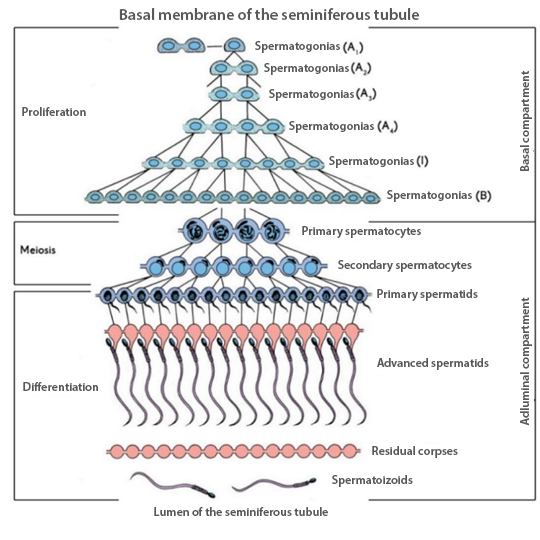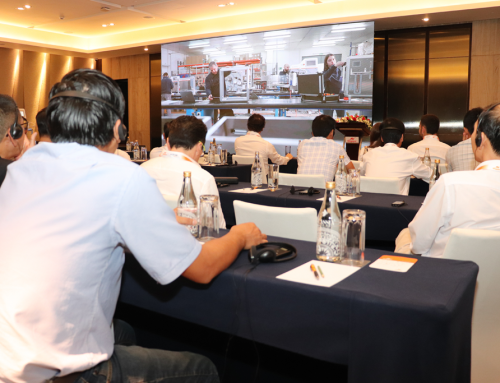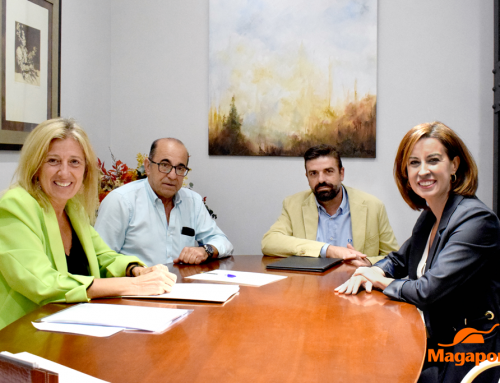Sperm are generated in the testicles by a process called spermatogenesis. Specifically, they are formed in the seminiferous tubules, which contain two types of cells: germ cells, which give rise to sperm, and Sertoli cells, which provide structural and metabolic support to the germ cells.
In the swine species, spermatogenesis lasts approximately 50-55 days, with 35-40 days for spermatogenesis itself and 10-16 days for maturation and transport from the testicle to the epididymis. This process consists of three phases:
- Proliferation: the spermatogonia divide, giving rise to primary spermatocytes, which are bound together to facilitate biochemical interactions and synchronized germline maturation.
- Meiosis: the primary spermatocytes (2n, have two sets of chromosomes) divide, generating secondary spermatocytes, which have half the genetic material (n, only one pair of chromosomes). These, in turn, divide, giving rise to spermatids.
- Differentiation or spermiogenesis: the spermatids mature and give rise to spermatozoa.

Figure 1. Representative schematic of the spermatogenesis process. Modified from Senger (2003) and Ross and Pawlina (2014). Source: Doctoral thesis Sara Miguel Jiménez (2023).
Spermatozoa are composed of the following parts:
– Head: genetic reservoir and protective barrier. It houses the cell nucleus, which contains the genetic information transmitted by the progenitor. It is encapsulated by a specialized membrane, which ensures genomic integrity during the migration of the sperm toward the ovule.
– Acrosome: the key to fertilization. Located in the apical region of the head, the acrosome plays a central catalytic role. It contains hydrolytic enzymes that, once released after the acrosomal reaction, facilitate the process of fusion of the sperm with the oocyte.
– Tail or flagellum: energy center and motor apparatus. It is the structure that enables sperm movement, and consists of two parts:
o Neck and midpiece: this is the proximal part of the flagellum and serves as an anchor with the head. It contains a high density of mitochondria, which are the organelles responsible for providing the cellular energy required by the spermatozoa to move.
o Axonema or distal part: this is the structure that acts as the sperm’s propulsion mechanism, using curving movements of the flagellum to produce vigorous and directional movements, allowing the sperm to advance toward the ovule.

Figure 2. Parts of the spermatozoa.
In short, the structure of the spermatozoa reveals an extraordinary complexity, with each part performing specific and essential functions. From the head, with its genetic cargo, to the tail, which drives motility, each structure contributes in its own unique way to the ultimate task of this cell: fertilization. In the next blog post, we will delve more deeply into the process of spermiogenesis and sperm maturation.
Bibliography
Estudio de la posible acción antioxidante, antiapoptótica y quimiotáctica de la melatonina sobre espermatozoides ovinos. Sara Miguel Jiménez. Tesis doctoral. Universidad de Zaragoza (2023)
Fisiología reproductiva del verraco: Espermatogénesis, SUIS Nº 75 Marzo 2011
Fisiología reproductiva del verraco: Fisiología espermática y producción de esperma, SUIS Nº 76 Marzo 2011




